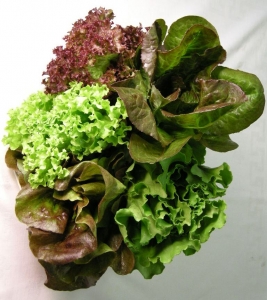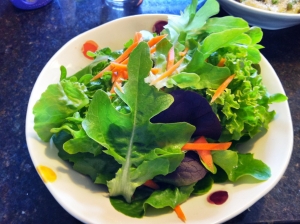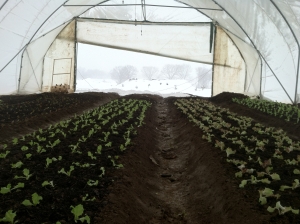All About Lettuce!
 Whenever I think about Blue Moon’s baby lettuce heads I think about Alex Levine, Whole Earth Center’s beloved deli manager. Last year when I delivered the seasons’ first baby lettuce harvest, Alex pulled a glistening head from the box, tore off a leaf, and began feasting—right there in the walk-in cooler. It was the first, fresh greenery he’d had since the previous autumn, and judging by the ecstatic look of satiety that filled his eyes, it was much needed. Like Alex, I’ll often eat lettuce straight from the head—greedily, luxuriating in the texture, the taste, the privilege of eating local lettuce so early in the season. And after a winter like this year’s, it’s just what the doctor ordered.
Whenever I think about Blue Moon’s baby lettuce heads I think about Alex Levine, Whole Earth Center’s beloved deli manager. Last year when I delivered the seasons’ first baby lettuce harvest, Alex pulled a glistening head from the box, tore off a leaf, and began feasting—right there in the walk-in cooler. It was the first, fresh greenery he’d had since the previous autumn, and judging by the ecstatic look of satiety that filled his eyes, it was much needed. Like Alex, I’ll often eat lettuce straight from the head—greedily, luxuriating in the texture, the taste, the privilege of eating local lettuce so early in the season. And after a winter like this year’s, it’s just what the doctor ordered.
Lettuce is so ubiquitous we rarely stop to think about its origins. It was the Egyptians who first cultivated the plant, turning it from an oil-producing weed into a crop grown exclusively for its leaves. They used lettuce to honor their reproduction god, Min, whose stamina was purportedly benefited by copious consumption of the crop. These early lettuce strains resembled a large version of romaine, and later spread to the Greeks, and then the Romans, and finally to Europe. It was the barbaric Christopher Columbus who brought lettuce, along with pestilence and disease, to the Americas.
Originally, lettuce had to be sold close to where it was grown, thanks in part to its short life span and delicate nature. But with the advent of new packing, storage and shipping technologies in the early 1900s, lettuce began to proliferate. The later development of ‘vacuum cooling’, which allowed for the crop to be cooled and packed in the field, only added to its popularity.
 At Blue Moon, we grow five varieties of baby lettuce heads. Red “Little Gem”, Green “Sucrine”, Green “Oakleaf,” Green “Sweet Crisp”, and red “Incised”. The first harvest of these beauties is always a special occasion—they are the very first crop of the season, and, as such, mark the arrival of spring. And whether you choose to enjoy them in a salad, on a wrap or sandwich, or, like Alex and I, straight from the head, they’re delicious.
At Blue Moon, we grow five varieties of baby lettuce heads. Red “Little Gem”, Green “Sucrine”, Green “Oakleaf,” Green “Sweet Crisp”, and red “Incised”. The first harvest of these beauties is always a special occasion—they are the very first crop of the season, and, as such, mark the arrival of spring. And whether you choose to enjoy them in a salad, on a wrap or sandwich, or, like Alex and I, straight from the head, they’re delicious.


